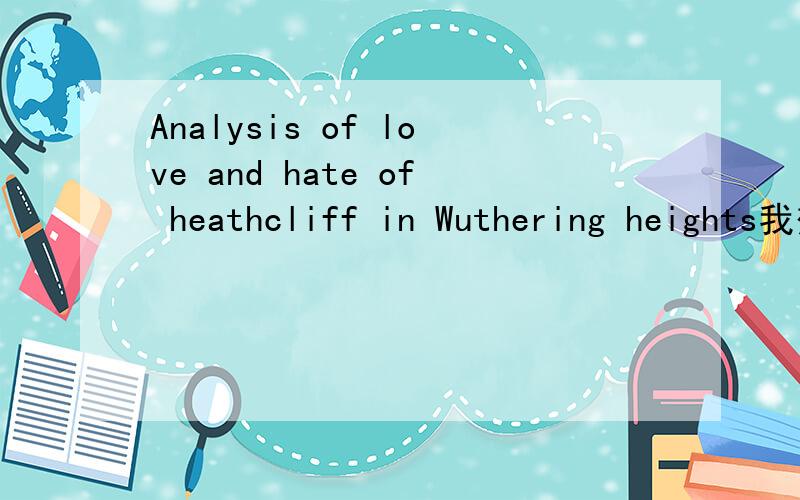Analysis of love and hate of heathcliff in Wuthering heights我想知道在 呼啸山庄 这部作品中是什么原因形成了希刺克厉夫那样扭曲的爱与恨.
来源:学生作业帮助网 编辑:作业帮 时间:2024/11/19 07:43:28

Analysis of love and hate of heathcliff in Wuthering heights我想知道在 呼啸山庄 这部作品中是什么原因形成了希刺克厉夫那样扭曲的爱与恨.
Analysis of love and hate of heathcliff in Wuthering heights
我想知道在 呼啸山庄 这部作品中是什么原因形成了希刺克厉夫那样扭曲的爱与恨.
Analysis of love and hate of heathcliff in Wuthering heights我想知道在 呼啸山庄 这部作品中是什么原因形成了希刺克厉夫那样扭曲的爱与恨.
Analysis of Heathcliff
Wuthering Heights centers around the story of Heathcliff.The first paragraph of the novel provides a vivid physical picture of him,as Lockwood describes how his “black eyes” withdraw suspiciously under his brows at Lockwood’s approach.Nelly’s story begins with his introduction into the Earnshaw family,his vengeful machinations drive the entire plot,and his death ends the book.The desire to understand him and his motivations has kept countless readers engaged in the novel.
Heathcliff,however,defies being understood,and it is difficult for readers to resist seeing what they want or expect to see in him.The novel teases the reader with the possibility that Heathcliff is something other than what he seems—that his cruelty is merely an expression of his frustrated love for Catherine,or that his sinister behaviors serve to conceal the heart of a romantic hero.We expect Heathcliff’s character to contain such a hidden virtue because he resembles a hero in a romance novel.Traditionally,romance novel heroes appear dangerous,brooding,and cold at first,only later to emerge as fiercely devoted and loving.One hundred years before Emily Brontë wrote Wuthering Heights,the notion that “a reformed rake makes the best husband” was already a cliché of romantic literature,and romance novels center around the same cliché to this day.
However,Heathcliff does not reform,and his malevolence proves so great and long-lasting that it cannot be adequately explained even as a desire for revenge against Hindley,Catherine,Edgar,etc.As he himself points out,his abuse of Isabella is purely sadistic,as he amuses himself by seeing how much abuse she can take and still come cringing back for more.Critic Joyce Carol Oates argues that Emily Brontë does the same thing to the reader that Heathcliff does to Isabella,testing to see how many times the reader can be shocked by Heathcliff’s gratuitous violence and still,masochistically,insist on seeing him as a romantic hero.
It is significant that Heathcliff begins his life as a homeless orphan on the streets of Liverpool.When Brontë composed her book,in the 1840s,the English economy was severely depressed,and the conditions of the factory workers in industrial areas like Liverpool were so appalling that the upper and middle classes feared violent revolt.Thus,many of the more affluent members of society beheld these workers with a mixture of sympathy and fear.In literature,the smoky,threatening,miserable factory-towns were often represented in religious terms,and compared to hell.The poet William Blake,writing near the turn of the nineteenth century,speaks of England’s “dark Satanic Mills.” Heathcliff,of course,is frequently compared to a demon by the other characters in the book.
Considering this historical context,Heathcliff seems to embody the anxieties that the book’s upper- and middle-class audience had about the working classes.The reader may easily sympathize with him when he is powerless,as a child tyrannized by Hindley Earnshaw,but he becomes a villain when he acquires power and returns to Wuthering Heights with money and the trappings of a gentleman.This corresponds with the ambivalence the upper classes felt toward the lower classes—the upper classes had charitable impulses toward lower-class citizens when they were miserable,but feared the prospect of the lower classes trying to escape their miserable circumstances by acquiring political,social,cultural,or economic power.
这篇分析得很地道.